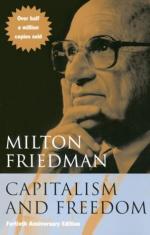
|
| Name: _________________________ | Period: ___________________ |
This test consists of 15 multiple choice questions and 5 short answer questions.
Multiple Choice Questions
1. What prefix were New Dealers commonly called?
(a) Ex.
(b) Un.
(c) Re.
(d) Ill.
2. Who does Friedman think can abuse licensure?
(a) Those applying for the licenses.
(b) An elite few in power.
(c) Special interest groups.
(d) Educational institutions.
3. What example does Friedman give for one argument for registration?
(a) Sex offender registration.
(b) Tobacco registration.
(c) Firearm registration.
(d) Alcohol registration.
4. Friedman claims there is no connection between equal treatment and what?
(a) Equal rights.
(b) Equal opportunity.
(c) Equal shares of income.
(d) Equal protection.
5. What has capitalism done for discrimination according to Friedman?
(a) Increased it.
(b) Abolished it.
(c) Reduced it.
(d) Widened.
6. What is the term for laws that forbid membership in a union a requirement for employment?
(a) Fair labor laws.
(b) Anti-union laws.
(c) Right to work laws.
(d) Employment standards laws.
7. To what does Friedman equate competition?
(a) A perpendicular line.
(b) The Prime Meridian.
(c) A parallel line.
(d) A Euclidean line.
8. What effect has Friedman observed that minimum wage laws have had on poverty?
(a) Spread it out.
(b) Reduced it.
(c) Maintained it.
(d) Increased it.
9. For Friedman, what is the main argument for licensure?
(a) Paternalism.
(b) Racism.
(c) Maternalism.
(d) Materialism.
10. According to Friedman, a liberal will welcome measures that promote what?
(a) Elimination of poverty.
(b) Wealth and freedom.
(c) Power and politics.
(d) Freedom and equality.
11. According to Friedman, Social security measures were enacted to make receipt of assistance a matter of ______.
(a) Right.
(b) Authority.
(c) Paperwork.
(d) Principle.
12. According to Friedman, what is the goal of government intervention regarding the distribution of income?
(a) Social welfare.
(b) Taxation.
(c) Job creation.
(d) Income equality.
13. Regarding certification, what does Friedman stress increases sales?
(a) Certificates of authenticity.
(b) Good products that maintain good reputations.
(c) Stringent certification controls.
(d) Word of mouth advertising.
14. According to Friedman, what is one major cost of the extension of governmental welfare activities?
(a) Higher taxes with low results.
(b) Increased regulation of private organizations.
(c) Decline in private charitable activities.
(d) Lower productivity of labor.
15. What is one disadvantage Friedman describes of programs to alleviate poverty?
(a) Funding.
(b) Authorization.
(c) Administration.
(d) Fraud.
Short Answer Questions
1. Friedman suggests that employees may prefer to have part of their remuneration take the form of amenities such as what?
2. What problem did Dicey write about in 1914?
3. What industry does Friedman use to explain his views on monopoly in labor?
4. Forming a list of who engages in what is known as ______.
5. What is one argument Friedman gives for public housing?
|
This section contains 412 words (approx. 2 pages at 300 words per page) |

|




